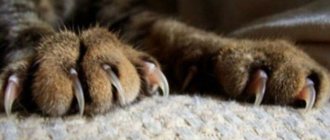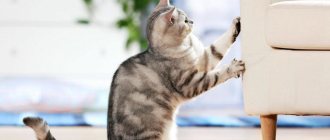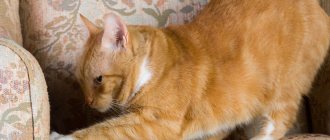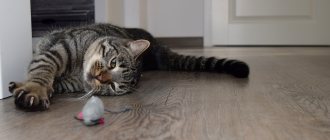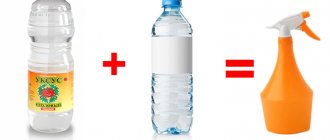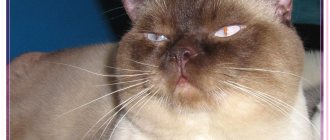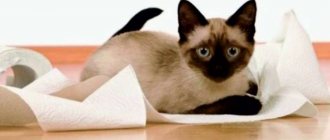What will you learn from the article?
- Why cats scratch furniture and wallpaper Physiological reasons
- Psychological reasons
- Behavioral reasons
- Step 1. Buy a scratching post
Sharpening claws is a natural need of a cat that must be satisfied. Domestic cats are deprived of their natural ability; they sharpen their claws on surfaces that remind them of the structure of wood. Often the choice of pets falls on wallpaper, corners of rooms and furniture.
In this article:
- Let's talk about the reasons why cats sharpen their claws on furniture and wallpaper;
- we will teach you how to stop a cat from tearing up wallpaper;
- We’ll show you how to save furniture from cat claws;
- We will recommend weaning methods and special repellents.
Why do cats scratch furniture and wallpaper?
The main function of scratching claws is to maintain the sharpness of the cat's hunting weapon. But this is not the only reason why a cat scratches wallpaper and tears up furniture.
To get rid of a bad habit, you must first understand the reasons for the unwanted behavior.
Physiological reasons
- Keeping claws sharp. A predator's claws must be sharp so as not to miss its prey.
- Exfoliation of the top dead layer of the claw.
- Claw marks and the smell of secretions released by the paw pads help the animal mark its territory.
- Warm up. When a cat sharpens its claws, it stretches to its full height, stretches its spine and muscles.
- Ritual of communication with other cats. Many animals stretch and scratch their claws in the presence of their fellow tribesmen.
Psychological reasons
The animal's psycho-emotional state pushes it to tear apart the sofa and wallpaper.
A cat scratches if:
- he is jealous. This way he can express his dissatisfaction with the fact that small children or new pets have appeared in the house.
- experiencing stress. A restless environment around the animal serves as a basis for scratching. Cats painfully endure preparations for moving, renovation work in the house, and the appearance of a cat in the next apartment.
- defends its interests and fights for territory. A tense relationship with a new pet or hostility between two cats will inevitably lead to claw marks on furniture and walls. This is how cats mark their territory and spread their scent over it.
- plays. A piece of wallpaper accidentally torn off while scratching a wall can encourage the animal to continue this activity. The hosts' reaction to this incident, even negative, makes the game even more exciting.
- doesn't feel safe. The pet tries to increase its security by spreading its scent throughout the apartment using scratches.
Behavioral reasons
- Lack or lack of education. A kitten scratches furniture and tears wallpaper if it was not taught to use a scratching post from an early age and its attempts to sharpen its claws wherever it wants were not stopped.
- Adult animals may behave inappropriately due to a change in owner, relocation, lack of attention from the owner, or deterioration in living conditions.
Buy anti-scratches
If all else fails and your furry pet is still scratching your furniture, try a funny invention - anti-scratch pads. These are small silicone caps that are glued to a cat's claws. They hold on to the claws perfectly until they grow back. They can then be re-glued. At the same time, the cat can calmly scratch the furniture without leaving any marks on it. Anti-scratch pads not only protect furniture from cat claws, but also look funny - almost like a manicure!
How to stop a cat from tearing furniture and wallpaper
Don't hold a grudge against cats, don't scold them for ruining wallpaper, carpet and furniture. Animals do this unintentionally, not with the intention of harming the owner. They act at the level of instincts inherent in nature.
To protect furniture, new wallpaper, carpeting, it is necessary to identify the cause of the behavior and eliminate it. If your animal is suffering from stress, seek help from a veterinarian or animal psychologist. If the reasons for scratching are not related to the psycho-emotional state of the pet, be patient to instill good manners in the cat.
Step 1. Buy a scratching post
Buying a scratching post that your cat will like is the best solution to the problem of sharpening its claws in the wrong places. Offer your cat several models, place them in different places. The animal must have a choice. For each pet in the house there should be at least two scratching posts of different textures and directions.
This cat accessory will allow your pet to satisfy its physiological needs. If the animal appreciates the capabilities of the scratcher, then you don’t have to worry about the wallpaper and furniture. Be patient and consistent; it may take several months to train your claws to scratch in the right place.
Read more: how to train a cat to use a scratching post.
Step 2: Create a safe personal space
Scratches on wallpaper and furniture can be a special form of marking and indicate a cat's insecurity. Reasons for concern for a pet may be neighbor's animals entering the area, quarrels between owners, or a conflict between the cat and other pets.
Repairing and replacing furniture is stressful for a cat. During repairs, animal odors that help you feel safe in the house are destroyed. They are replaced by foreign aromas of building materials, new furniture and floor coverings. This worries the pet. The cat scratches things and wallpaper to make the space of the house more friendly, transmitting its smell to it.
How an owner can help an animal feel more confident
- Install cat doors to keep other animals out of your home.
- Monitor relationships between pets. Create for everyone their own resting place, preferably on an elevation, to make it more convenient to observe what is happening in the house. Provide each pet with its own litter tray.
- Give the cat its own place in the house. Create an area for playing and climbing, provide a house in which the animal can hide and be alone.
- Help your cat spread its scent around the house after renovating and replacing furniture. To do this, rub the animal's cheeks with a soft cloth, and then wipe the corners of the house, furniture legs, and door frames with this cloth.
- Never physically punish unwanted behavior. The owner should be a source of security for the cat, and not an additional threat.
Step 3. Trim nails regularly and use anti-scratch guards
Regular cat manicures will protect walls and furniture from sharp claws. If you carefully cut off the dead part of the claw as it grows, then the cat will not have the desire to sharpen its claws again. You can trim your nails at home, using caution. Or entrust this procedure to a professional from a grooming salon.
The Anti-Scratch claw device is another useful accessory that protects the home’s furniture and wallpaper from damage. These soft pads avoid the controversial and very painful declawing procedure. Cats wearing anti-scratch guards will also sharpen their claws, but will not harm any surfaces.
Step 4: Clean scratched areas
When cats use scratches as territorial marks, they return to refresh the mark. To prevent your pet from returning to the scratch site again and again, clean it thoroughly. Try to completely remove the cat odor using detergents and disinfectants.
To stop a cat from scratching the sofa, the soft upholstery is washed with a solution of washing powder and then wiped with an alcohol-containing liquid. While the treatment area dries, the cat should be kept in a separate room. After drying, this place can be additionally treated with a spray with a citrus scent or use a special “Anti-claw” spray.
Step 5. Use aids
You can use strong smells that repel cats to wean your pet from a bad habit. Cats have an excellent sense of smell; strong-smelling substances are unpleasant and repulsive to them. If you spray one of these scents on a surface that your pet uses for sharpening its claws, your cat may give up the habit.
Most often used to wean off scratching:
- citrus aromas;
- acetic acid;
- essential oils (eucalyptus, lavender, lemongrass);
- strong alcohol;
- sharp perfume.
Spraying is carried out using a spray bottle. The repellent is pre-diluted in water. Choose those scents that will not be unpleasant to the owners and will not greatly spoil the smell in the apartment.
Instead of these home remedies, you can use special products to stop cats from scratching. These sprays are sold in pet stores and veterinary pharmacies. Next, we will talk about the best means and their cost.
Another way to protect your furniture is to apply double-sided tape to the scratched areas. Cats do not like sticky surfaces; touching the tape with their paws will be unpleasant for them. The animal will no longer scratch in this place.
Step 6. Choose the right wallpaper
While furniture can be sprayed with professional or homemade repellents to protect against cat claws, wallpaper is more difficult to save. After spraying the “crime scene,” stains and unpleasant stains remain on the wallpaper. In addition, odors from wall surfaces evaporate faster; the procedure will have to be repeated again and again.
What wallpaper to choose if there is a cat in the house:
- non-woven;
- wallpaper with silk-screen printing;
- washable wallpaper.
A real salvation from cat pranks is anti-vandal wallpaper. This is a new wear-resistant type of finishing materials. To enhance the wear resistance of this wallpaper, the manufacturer uses additional external coating and reinforcement.
Types of anti-vandal wallpaper:
- vinyl “anti-claw”;
- fiberglass for painting;
- non-vandal resistant non-woven fabrics for painting;
- laminated;
- textile-based vinyl;
- vinyl on non-woven base.
No covering, even the most stable one, will be able to wean a cat from a bad habit unless you buy him a scratching post and teach him to use it.
Overlays
To discourage your pet from scratching wallpaper and furniture, you will need special anti-scratch pads. This accessory is presented in the form of soft caps, which allows you to quickly eliminate the problem of scratching.
However, this method is quite troublesome and expensive. The pads will need to be changed every 2-3 weeks. After removing them, the cat's claws need to be filed. Only then is it allowed to glue new anti-scratch pads. It is better to carry out the procedure in a pet salon.
Thanks to the overlays, you can protect furniture and wallpaper, but their use is possible as a temporary measure. This is explained by the fact that the caps prevent the cat from staying on the surface, so falls from a height are not excluded.
The means used to attach the caps can lead to an allergic reaction or abscess if the pet injures a finger while wearing it. The cat may feel pain because the anti-scratch guards do not allow the claws to retract. The possibility of scratching is also excluded. When trying to rip off the caps, the pet may injure its fingers or pull out its claws. Before you put anti-scratch pads on your pet, think carefully. For cats that go outside, this method of preserving furniture and wallpaper is not suitable.
Useful tips for cat owners
- Don't rush to throw away your old scratching post. If you purchased a new accessory for sharpening cat claws, place it next to the old claw grinder, which is saturated with familiar odors. Throw away the old one only when the animal gets used to the new one.
- Use the Kuklachev method. To stop a cat from scratching wallpaper, glue a piece of “favorite wallpaper” onto a board and place it in the place where the cat is used to scratching the wall. Every day the board is moved to the place where the scratching post is located.
- Applaud the cat. As soon as the animal begins to sharpen its claws in the wrong place, clap your hands loudly. You can hit the floor with a slipper - it will have the same effect.
- Believe in the power of your word. Sternly say “No!” when the cat starts scratching the furniture or wallpaper. Don't shout, speak confidently. Repeat this command every time your pet is about to sharpen its claws in the wrong place. Over time, he will understand that the owner does not approve of this behavior.
Make sticky surfaces
It is also known that cats do not like sticky surfaces. Therefore, another idea: you can stick double-sided tape on the “wrong place”. There is also adhesive tape that has a transparent base and will not be very noticeable on interior details. Once your pet has become accustomed to this area, the tape can be removed.
Means for repelling cats from wallpaper and furniture
In veterinary pharmacies and pet supply stores you can purchase special repellents that can be used to treat furniture, walls, door frames and other places where cats sharpen their claws. The unpleasant smell of these products disgusts cats, and they avoid the treated areas.
Best scratch repellents:
- Beaphar Stop It Cat is an effective spray for repelling cats from wallpaper, furniture and indoor flowers. Price: bottle 100 ml. – 740 – 890 rub.
- Nature's Miracle, JFC Pet Block Cat Repellent Spray is a concentrated spray based on natural repellents. Price: bottle 236 ml. – 440 – 470 rub.
- Spray Mr. Fresh is a means to prevent cats from tearing wallpaper. Suitable for kittens and cats. Price: 200 ml bottle. – 180 – 280 rub.
- Spray lotion VioVax “Repel? Yes!" – based on natural ingredients, protects furniture and walls from scratching. Price: bottle 180 ml. – 123 – 160 rub.
- Api-San Smart spray - protects against chewing and scratching. Price: bottle 200 ml. – 180 – 265 rub.
Scare away with strong odors
If water doesn't help, try to distract your cat from the furniture with unpleasant odors: cats are known to not tolerate the smells of citrus fruits, vinegar, lavender, eucalyptus, rosemary and many others. Try sprinkling a little lemon or eucalyptus essential oil on your furniture - this will not only distract your cat from her favorite place to sharpen her claws, but will also fill the house with a pleasant aroma.
How not to wean
It is better not to use these weaning methods if you want to achieve a positive result and remain on good terms with the cat:
- Spray bottle with water. To scare away a cat, taking advantage of its dislike for water procedures, water is sprayed on its face from a spray bottle. This method may work, but the animal will begin to associate this unpleasant event with your personality and will try to take revenge.
- Scream. Remember that you can scold a cat, but you cannot shout at it. Never scream when you stop a cat with a voice command. Screaming will scare the animal, but will not bring the desired result.
- Physical punishment. You can't hit cats! The animal will get scared, harbor a grudge, and try to take revenge.
- Late identification of the problem. You can scold a cat only when you take it by surprise at the site of vandalism. If the wallpaper is already torn off, the furniture is scratched, there is no point in expressing your attitude towards this. The animal will not understand why you are scolding it.
Reasons for property damage
Of course, the harmful actions of furry fidgets in tearing wallpaper off the walls and turning an upholstered chair into rags are not intended to spoil the owner’s property. The animal does not understand the value of new expensive upholstered furniture, and even more so has no idea about the amounts spent on home renovations. The cause of material damage is of an understandable physiological nature.
In the wild, cats have an unhindered opportunity to sharpen their claws on a tree trunk. Such manipulation is necessary for the animal to maintain the cat's manicure in combat readiness. Sharp claws protect the furry animal from numerous enemies and help in successful hunting.
In addition to grinding down the claws, the animal needs physical exercise. By stretching on a vertical surface, the pet warms up the muscles of the neck and back and keeps them in good shape. Such manipulations are especially important for domestic cats leading a sedentary lifestyle. Vertical stretches prevent the development of physical inactivity and diseases of the musculoskeletal system.
The ritual of sharpening claws on vertical objects also has practical significance from the point of view of drawing the boundaries of one’s territory. Under the pads of cats there are specific glands that produce a secretion individual to each individual. This helps the animal to mark its territory and prevent other relatives from encroaching on the territory.
In apartment living conditions, domestic cats are forced to realize their natural instincts using improvised means. Most often, pets choose upholstered furniture and vertical surfaces - walls covered with wallpaper.
Understanding the physiological reasons why a cat tears wallpaper, knowledge of the basics of animal behavior will tell the owner what to do in such a situation.

